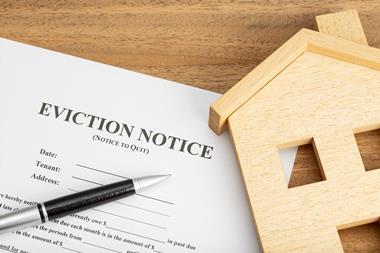The government has outlined several affordable housing reforms in its Social Housing Green Paper, including proposed changes to council spending of Right to Buy receipts, shared ownership and the regulatory system.

Measures include reviewing rules on how councils can spend Right to Buy receipts, publishing league tables to highlight the performance of landlords with a ratings system, and enabling tenants to buy as little as 1% of their home each year through shared ownership – but it does not commit any new funding to developing new social housing.
The document was launched today by communities secretary James Brokenshire. Its proposals include:
- Improving the design of new social housing
- Considering allowing councils to be more flexible in how they spend the money from homes sold under the Right to Buy scheme, and not requiring them to sell off vacant, higher value stock.
- Considering ways to allow people using affordable home ownership schemes like Help to Buy to build up more equity in their homes, including by allowing them to buy as little as 1% of their home each year.
- Improving the landlord complaints process for residents
- Giving the regulatory system for social housing ‘sharper teeth’, and launching a call for evidence on how it is currently operating
- Introducing league tables to highlight the performance of landlords with a ratings system
The document also forms part of the government’s reform of social housing following the Grenfell tragedy, and the government said it would “consider how the Decent Homes Standard should be reviewed to ensure it delivers the right standards for social housing residents.” The report said that remediation work to remove or replace unsafe cladding has started on 70% of buildings in the social housing sector, and that the government would consider updating the Decent Homes Standard which was last revised in 2006.
Find out more - After Grenfell: ACM cladding investigation
Launching a consultation on the proposals ahead of the full green paper’s release, Brokenshire said: “Our Green Paper offers a landmark opportunity for major reform to improve fairness, quality and safety for residents living in social housing across the country. Regardless of whether you own your home or rent, residents deserve security, dignity and the opportunities to build a better life.”
The document has drawn criticism from the social housing sector, as it does not commit any extra funding for developing new social housing. Shelter’s chief executive Polly Neate said that the green paper was “full of warm words but doesn’t commit a single extra penny towards building the social homes needed by the 1.2 million people on the waiting list.”
The Green Paper does acknowledge the need for more social housing, however. ”At Budget 2017 we stated that our ambition is to increase the average number of new homes delivered each year to 300,000 by the mid-2020s,” it says. ”To achieve this we will need to increase all types of supply, including social homes.”
The green paper was first announced in September last year, by then-communities secretary Sajid Javid.
Local Government Association housing spokesperson Cllr Judith Blake, added: “This Green Paper is a step towards delivering more social homes but it is only a small step, compared with the huge and immediate need for more genuinely affordable homes. We have long called for reforms to Right to Buy in order to allow councils to build more homes, and there are some positive signs in the consultation. But we must go much further so that councils can deliver the affordable homes that our residents need and deserve, including allowing councils to set discounts locally and to keep 100% of receipts from homes sold.”
Homelessness and supported housing strategies
The Green Paper was launched a day after the government unveiled its £100m strategy to tackle rough sleeping. Separately, the government has also today announced £76m funding to build and develop thousands of homes designed for people with disabilities, mental health issues and older people who need extra support.
The Care and Support Specialised Housing Fund (CASSH), originally launched in 2012 and now extended to 2021, is run in partnership with Homes England for schemes outside London, and the Mayor of London for London-based schemes, who implement the programme to develop supported or specialised housing designed to be accessible by having features including:
- individual homes with their own front door
- flexibility to adapt or install equipment or assistive technology in the home
- varying levels of personal care and support to residents, including access to GP or other health services
- communal areas (for housing for older people).
Minister for care Caroline Dinenage said: “No one should have to go into a residential home or get stuck in hospital because of a lack of specialised housing adapted to suit their needs. This programme provides a vital life line for some of the most vulnerable people in society to live their own lives in a home that works for them.”
Property reacts
-
Geeta Nanda, chief executive of Metropolitan: “This Green Paper draws on lessons learned in the past few years, and is a step forwards in delivering real, positive change for our residents. As policies develop from the Green Paper, above all else the voice of residents must continue to be heard loud and clear – both by the government and by us as housing providers. There is still much more that needs to be done by government and by us as a sector to ensure everyone has a safe, decent and affordable home to live in. We will work with the National Housing Federation and others to inform the sector’s response to what should be an important milestone for us all.”
- Mark Farmer, chief executive at Cast: ”The recommendations of the social housing green paper are further evidence that the Government understands the severity of the housing crisis and the need to increase the delivery of high quality new homes. However, tackling the housing crisis head-on needs much more focus on delivering affordable homes in appropriate locations with appropriate social and physical infrastructure that can generate sustainable communities. This can only be achieved by bringing forward more public land for development and diversifying our housing market both in terms of tenure offering and methods of production. There is a unique opportunity to use innovative homebuilding techniques as a stimulus for new forms of multi-skilled training, factory & site based employment and wider social value creation.”
- Ed Fowkes, development director at Prosperity Capital Partners: “The social housing green paper is a welcome declaration of support for tenants and of the empowerment of local communities. As the government sets out plans to deliver affordable housing targets, local authorities should use this renewed flexibility to find smart ways of delivering quality social homes, improving the image of the sector and helping to address housing shortfall in key locations. Tenants deserve decent homes to live in, and we hope that this year’s social housing green paper will strengthen the voice of the vulnerable, and solve many of the supply side problems that have stunted social housing delivery throughout Britain.”
- Ruth Cooke, chief executive of Clarion Housing Group: “Our residents tell us that living in a safe, good quality home is of the utmost importance to them, so we welcome the Government’s proposals to ensure this is provided to everyone living in social housing. We call for meaningful reforms that improve quality and service for all residents. As we face the most acute housing crisis for a generation more must also be done to drive up the supply of new social and affordable homes, which are so desperately needed.”
- Félicie Krikler, director at Assael Architecture: “The social housing green paper is a much-needed step to give a voice to tenants. Vitally, the green paper notes the importance of safety and design considerations including the public realm within the social housing sector. By rewarding great, conscious and community-focused design and neighbourhoods, central and local government can help tackle stigma around social housing and instil a sense of pride in space and place. The living experience should be at the centre of planning and delivering affordable homes, otherwise it will be more of the same.”
-
Paul Hackett, chair of the G15 group of housing associations and chief executive of Optivo: “As housing associations, we’ve had to adapt in recent years, innovating and finding new ways of raising the funds needed to keep delivering the affordable housing this country needs. But building and managing homes is far from all we do. Against a backdrop of strained public services, we help improve tenants’ lives and communities by providing employment, skills and education programmes and investing in local facilities. The green paper is a step forward for social housing tenants, but higher grant levels and bigger funding programmes will be required in the long term if we’re going to tackle the housing crisis.”
-
Brian Cronin, chief executive of Your Housing Group: “It is crucial that above all we solve the problem of housing supply.The green paper needs to provide the green light for additional private sector investment into social housing. Social housing landlords manage hundreds of thousands of homes and are committed custodians of these homes for the long-term, providing potential investors with a steady, long-term return. This is perfect territory for institutional investors like pension funds to link up with housing associations to develop a transformative model where new affordable homes could be delivered at a seriously large scale.”
-
Bjorn Howard, chief executive of Aster Group: “It’s pleasing to see the government recognise the role that shared ownership has to play in alleviating the housing crisis. We and other housing associations have highlighted the importance of this type of tenure in offering an aspirational and secure way for people to work towards their dream of owning their own home. It is disappointing, though, that the green paper doesn’t outline plans for any new investment. Significant funding is needed to ensure the most vulnerable in society are provided with good-quality homes.”
- Tonia Secker, partner at Trowers & Hamlins: ”The Green Paper rightly focusses on the relationships between residents and those who own and manage the homes they live in. This is a difficult and complicated area. Some “yardstick” of quality is necessary, but whether a “league table” approach is useful is the right one remains to be seen – particularly in circumstances where an individual’s choice of landlord is constrained. The additional resource and infrastructure required to implement such a system risks both cutting across the role of the Regulator and muddying the waters. What is needed is more clarity and unification of function rather than less. It will be disappointing for many councils that the HRA debt cap has not been lifted but they will be hoping that an oversubscribed bidding round will lead to further opportunities. Let’s see. Councils will nonetheless be pleased that Higher Value Void levy has now been abandoned and should provide additional confidence to invest in new homes.”
- Henry Moss, real estate partner at law firm Ashurst: “The Social Housing Green Paper is welcome but it does nothing to fix the fundamental problem that we’re not building nearly enough homes of the type people desperately need or can afford. The Government’s own Housing White Paper, published over 18 months ago, described our housing market as “broken” and promised to “fix it”. Since then we have had consultation after consultation but no action.”






























No comments yet